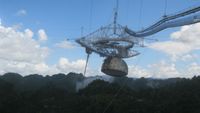The Science Pages
All the stuff they pay me to do
My main research interest is in galaxy evolution. Although I have occasional delusions of running numerical simulations, by training I'm strictly an observer. Most of my research is based around radio observations of the neutral atomic hydrogen (HI) which comprises most of the gas content of typical galaxies.
Beginning with my PhD, I've been involved with the Arecibo Galaxy Environment Survey (AGES) almost since it began back in 2006. This project used one of the world's largest, most sensitive telescopes to hunt for galaxies by detecting their HI signal, looking in 16 carefully-selected target regions in different parts of the sky. Galaxies exist in all sorts of different environments, from very low density "voids" where there are hardly any galaxies at all, up to rich clusters thousands strong, and our target regions were chosen to sample all of these. AGES has broad-ranging goals and tries to understand all aspects of how the gas is affected by different environments. This is important because ultimately it's the gas that determines star formation.
My personal favourite pet topic is looking for candidates for optically dark galaxies, objects where the HI looks like it's rotating as in a normal galaxy – suggesting the presence of a dark matter halo – but with no detectable stars. Besides this I'm interested in everything about how the HI relates to galaxy evolution, especially as a function of environment : which gas-loss mechanisms are most important in different conditions, how much damage they can do, and how we identify which processes are at work. I also design software and tools for source extraction, turning the seething mass of raw data into useful catalogues.
AGES spawned a successor survey, WAVES, which was intended to eventually map the whole of the Virgo Cluster to the same sensitivity of AGES. This was cut short by the collapse of the telescope, but together with the AGES data, there's still more than enough here to keep us busy for years to come. Discoveries have prompted follow-up observations with the VLA and the Chinese FAST telescope, which I'm (very slowly) in the process of investigating.
Since 2013 I've been based at the Astronomical Institute of the Czech Academy of Sciences in Prague, where I also provide user support to ALMA users as part of the Czech ARC node.
The following pages give a bit more detail on some of my main research interests. For more on my day-job stuff, see the Research Experience section. What I want to do here is to provide a basic outline for a general audience, but I also want to make sure that certain information is "out there". Far too often, people look at you funny if you don't know something that no-one's ever explained properly. How they know this is a mystery to me, but this is my attempt to at least distil some small part of it down to an easy-to-understand version. The internet may well be the sum total of human knowledge, but sometimes it's not at all easy to find or explained in simple way.
Dark Galaxies : What are galaxies without stars ? Why are they important ? This page gives a brief overview, with some more in-depth look at particular dark galaxy candidates I've had some level of experience in investigating.
Ram Pressure Stripping : A very quick look at the (probably) biggest cause of gas loss in clusters, and how we can go about detecting direct signatures of this using atomic hydrogen gas.
Tidal Encounters : The other major risk that galaxies suffer, almost wherever they go, is each other. This page looks at how we detect this. I also have some experience of numerical simulations of this.
Source Extraction : On the increasingly rare occasions when I have nothing else to do, or if I just really want to, I like to go through an HI cube and catalogue all the detections. This section describes the major techniques for doing this, from finding ordinary galaxies to stacking the signals of undetected objects to increase the sensitivity.

